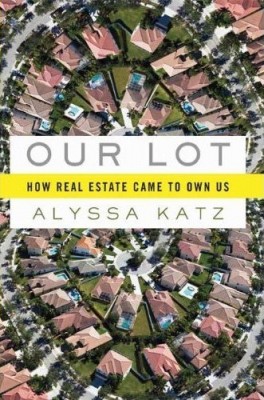
Our Lot: How Real Estate Came to Own Us
by Alyssa Katz
–Reviewed by Jodie Liu
 In the real estate business, it can be hard to tell where Wall Street stops and Main Street begins. As Alyssa Katz suggests in Our Lot, the blurry nature of this divide may well be the reason for the collapse of the real estate market. From Franklin Roosevelt’s Depression era “National Homeownership Strategy” to the current financial crisis, Katz incisively shows that what began as an “attempt to help all American households become homeowners,” became, though speculative gambles and inflated sales quotas, a national catastrophe.
In the real estate business, it can be hard to tell where Wall Street stops and Main Street begins. As Alyssa Katz suggests in Our Lot, the blurry nature of this divide may well be the reason for the collapse of the real estate market. From Franklin Roosevelt’s Depression era “National Homeownership Strategy” to the current financial crisis, Katz incisively shows that what began as an “attempt to help all American households become homeowners,” became, though speculative gambles and inflated sales quotas, a national catastrophe.
According to Katz, those who correlate the recent stock market crash to the Black Thursday crash in 1929 are spot on, though probably not in the way they suspect. In response to the financial collapse, President Roosevelt pushed towards homeownership with the belief that “owning homes would serve as a force to better the world – to build stronger families, more pleasant communities, financial security, a sharing of wealth through the generations.” But the irony, Katz argues, is that Roosevelt’s antidote for the Great Depression all but assured the current economic downturn by instilling a dangerous notion in the American psyche: that “lack of experience” shouldn’t stop anyone from purchasing a home.
Lending companies capitalized on the mentality. In the decades that followed the Great Depression, national lenders Fannie Mae and Freddie Mac increasingly “made working people comfortable with the idea of taking on vast debt as the price for participating in the American Dream.” But they weren’t, as other reports have suggested, the sole perpetrators of the subprime loan fiasco. Katz shows that localized mortgage brokers were all too eager to pick up the risky, unsubstantiated loans that Fannie and Freddie didn’t take on, sometimes fabricating information to make loans appear credible on paper or even intentionally targeting those who did not have the means to pay back their loans. Unaware homeowners were happy to oblige, seduced by the lure of grand homes at less-than-grand costs.
The origin of mortgage meltdowns is not Katz’s only concern. She excels at capturing the aftermath of the reckless lending through accounts of working-class struggles. In Cleveland, Ohio, a city whose map of foreclosures she describes as “a port-wine stain colliding with a Rorschach test,” Katz details Barbara and Robert Anderson’s efforts to hold on to their house, which had been set for auction four times. In Philadelphia, Katz writes of a 76-year-old living on Social Security who “only wanted to redo the siding on her house – to cover up graffiti and keep the place warm, or so she hoped – but instead ended up with a $15,000 loan she had no way of paying back.”
Katz’s work may resonate strongest with America’s most indebted and disenfranchised homeowners. In the final chapter, she fiercely defends rent-regulated apartment tenants in New York City against commercial real estate developments that strongly favor owners. But the sobering reality she conveys has a lesson for all Americans – the real estate bubble rested on a tremulous foundation that spanned the nation and ran decades deep.
Excerpt: “Though ideologues on both sides have tried mightily, it’s impossible to make a blanket case for or against rent control, any more than it’s possible to say that police are always a force for good. A creature of local government and even more local real estate markets, their success or failure depends on gathering good information, exercising the political will to calibrate the annoying details of administration, and taking leadership to reconcile conflicts when they do (inevitably) arise.”
Further Reading: Busted: Life Inside the Great Mortgage Meltdown and Confessions of a Subprime Lender: An Insider’s Tale of Greed, Fraud, and Ignorance




Send A Letter To the Editors